On-Chip Broadband Mid-Infrared Supercontinuum Generation Based on Highly Nonlinear Chalcogenide Glass Waveguides
- 1State Key Laboratory of Optoelectronic Materials and Technologies, School of Electronics and Information Technology, Sun Yat-sen University, Guangzhou, China
- 2Tianjin Key Laboratory of Micro-scale Optical Information Science and Technology, Institute of Modern Optics, Nankai University, Tianjin, China
- 3Department of Optoelectronic Engineering, JinanUniversity, Guangzhou, China
- 4Southern Laboratory of Ocean Science and Engineering (Guangdong, Zhuhai), Zhuhai, China
On-chip mid-infrared (MIR) supercontinuum generation (SCG) covering the molecular functional spectral region (3–12 μm) offers the advantages of robustness, simplicity, and compactness. Yet, the spectral range still cannot be expanded beyond 10 μm. In this study, on-chip ultrabroadband MIR SCG in a high numerical aperture chalcogenide (ChG) waveguide is numerically investigated. The ChG waveguide with a Ge-As-Se-Te core and Ge-Se upper and lower cladding is designed to optimize the nonlinear coefficients and dispersion profile. Assisted by dispersive wave generation in both short- and long-wavelength range, broadband SCG ranging from 2 to 13 µm is achieved. Besides, a fabrication scheme is proposed to realize precise manipulation of dispersion design. Such results demonstrate that such sources are suitable for compact, chip-integrated molecular spectroscopy applications.
Introduction
Capturing the distinctive spectral fingerprints of molecules in the infrared (IR) region is of vital importance in molecular spectroscopy applications for environmental and health monitoring [1–3]. IR spectroscopy is considered the gold standard for molecular structures identification by detecting the distinctive spectral fingerprints of molecules in IR region covering 3–12 μm [4]. As laser-based light sources directly accessing the IR region, supercontinuum generations (SCGs) have attracted great attention due to their broad bandwidth, spatial coherence, and high brightness compared with the current mid-infrared sources [5]. Especially, when the SCG can be achieved in photonic integrated waveguides, the SCG platforms benefit from high lithography accuracy, dramatic compactness, high yield, and low power consumption [6, 7]. Typically, a femtosecond pulse laser is used to pump the nonlinear waveguide which has a wide transmission range and high nonlinear refractive index (n2) with dispersion engineered for broadband SCG. However, up to now, very few demonstrations successfully extended the reach into the mid-IR [7].
Recently, SCG based on chalcogenide glasses (ChGs) has shown particular potential, which are well known for their wide transparency window, high Kerr nonlinearity, and low two-photon absorption and are promising material platforms for photonic integrated nonlinear devices [8]. More importantly, as amorphous materials, the optical and mechanical properties of ChGs can be optimized by adjusting the composition. To date, a few of ChG-based fibers and waveguides have been fabricated and used for their practical applications. For example, a robust SCG with a high average power of 550 mW can be used as IR source to detect CS2 gas [5]. A stable and repeatable SCG with a power of around 20 mW was experimentally demonstrated using the Ge-As-Se/Ge-As-S rib waveguide, and an absorption spectrum of the polystyrene film has been obtained [9]. Very recently, our work on improved 2-micron optical interconnection using on-chip chalcogenide glass photonic integration has shown the promising prospect for photonic integration at the MIR waveband [10].
Yet, achieving MIR SCG with long wavelength of more than 10 μm in chip-scale waveguides remains a challenge. For SCG based on on-chip photonic waveguides, dispersion engineering is an efficient way to extend the SC to longer wavelengths. Multilayer waveguide structures have been proposed to flatten waveguide dispersion with multiple zero dispersion wavelengths (ZDWs), which can be used to generate broadband SC [11, 12]. Moreover, soliton-induced dispersive wave (DW) generation is an ideal mechanism that can coherently and efficiently broaden SC over a large frequency span [13] and enable ultrabroadband SCG without complex waveguide structures [7, 14, 15]. In addition, the mode at longer wavelengths expands significantly outside of the waveguide and does not overlap well with that at shorter wavelengths. The high NA would ensure a high light confinement at all wavelengths, which provides a substantial increase in the effective nonlinearity, and modes overlap over a broad wavelength span. Therefore, for broadband SCG, proper waveguide structure design is of vital importance to achieve a balance between MIR wave confinement and dispersion engineering in such waveguide.
In this work, a highly nonlinear chalcogenide waveguide with a Ge-As-Se-Te glass core and Ge-Se glass upper and lower cladding with NA of 2.07 is proposed and designed. A broadband SC from 2 to 13 μm assisted by dispersive wave generation is numerically demonstrated by launching a 120 fs, 800 W peak power pulse in such a waveguide. In addition, we propose a fabrication scheme to realize the precise manipulation of dispersion design. The proposed SCG holds great potential for the compact trace gas sensing and biomedical diagnostics.
Concept and Waveguide Structure
Among the ChG family, the ChGs based on sulfur and selenium show the transparency cutoff between 10 and 15 μm due to their higher phonon energies. The telluride (Te) glasses have lower phonon energies, resulting in broader transmission windows extending to more than 20 μm [16] and higher third-order nonlinearity [17]. However, the Te ChG has a poor transmittance in the short wavelength below 3 μm and is easy to crystallize. Here, we prepare and purify a Te-Se hybrid glass Ge20As20Te45Se15 (Ge-As-Te-Se) with a wide transmission window covering 2–16 μm region and superior thermal stability against crystallization during the film deposition process, which is chosen as the core material. The nontoxic Ge21.5Se78.5 chalcogenide glass is chosen as the upper and lower cladding, as shown in Figure 1A.
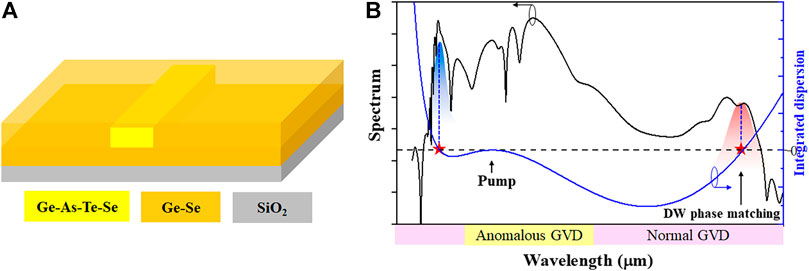
FIGURE 1. (A) The structure of the proposed all-chalcogenide waveguide. (B) Schematic presentation of soliton-induced dispersive wave (DW) generation: a DW related to soliton can be stimulated when the spectral regions satisfy zero-phase mismatching (where
The transmission spectrum of the core and cladding glasses is shown in Figure 2A. Moreover, an IR ellipsometer (IR-VASE MARK II, J. A. Woollam Co.) has been used to characterize the refractive indices of the core and cladding glasses, as shown in Figure 2B. Using our measured refractive index, the nonlinear refractive index (n2) can be determined by the following equation [18]:
where n0 is the linear refractive index and the calculated
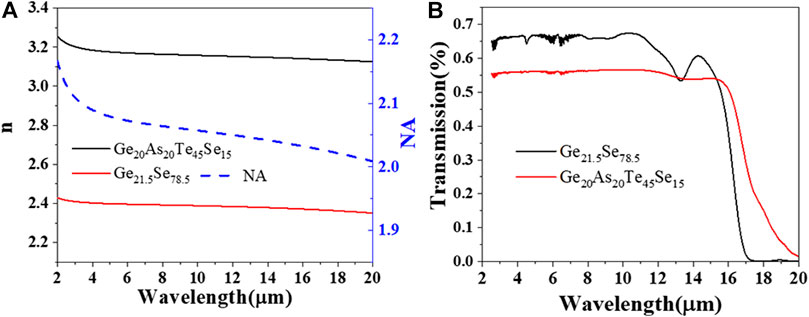
FIGURE 2. (A) Optical transmission spectra of the Ge-As-Te-Se and Ge-Se bulk glasses. (B) Measured linear refractive index of the Ge-As-Te-Se and Ge-Se ChG film and correspondingly calculated NA.
SCG occurs when a sufficiently powerful femtosecond pulse propagates through nonlinear nanophotonic waveguides and generally experiences a temporal compression and spectral broadening. Especially, the high-order soliton dynamics will be induced when the pulse laser propagates in a flat and low anomalous group velocity dispersion (GVD) region [19], facilitating a self-phase modulation (SPM) enabling spectral broadening and temporal compression, and the degree is proportional to the soliton number [20]. The soliton number (N) determines the relative interaction intensity between nonlinearity and dispersion, and the soliton number is often designed to be
where
where
where
where τ1 and τ2 are the Raman period and lifetime. There is no publication for Raman response function for Ge20As20Te45Se15. Here, the coefficients of As2Se3 chalcogenide glass have been used for the simulation [22].
At the compression point, the effects of high-order dispersion (HOD) on the propagating solitons will cause the energy conversion from the soliton to a spectral region in the normal GVD regime, causing the emission of dispersive waves (DWs) [19]. The phase-matching condition of DW generation can be given with the same phase constant of the soliton pulse and the linear waves [13]:
where β,
The phase-matching condition of the zero-integrated dispersion determines the location of DWs [23, 24]. Figure 1B shows the principle of soliton-induced DW generation [19]. When the spectral regions satisfy zero-phase mismatching (where
As for ChG-based SCG, the laser-induced damage threshold (LDT) is important when dumping femtosecond pulse with high peak power into the waveguides. The intensity threshold Ith can be calculated by the following equation [25]:
where Pcr is the critical average powers when the observable modification on the surface is induced, Ppeak, D, R, and τ are the corresponding peak power, diameter of the beam spot, repetition rate, and pulse duration, respectively.
Results and Discussion
Dispersion Engineering for DWs Phase Matching
Firstly, the effects of structural parameters on dispersion and integrated dispersion are systematically investigated. Figures 3A,C show the calculated GVD with different widths and heights for both fundamental TM and TE modes. Two zero dispersion wavelengths (ZDWs) can be obtained with engineered dispersion in the MIR region for these two modes. At short wavelengths, the material dispersion dominated a ZWD, leading to first DW generation. And at longer wavelengths, the waveguide dispersion can compensate a large anomalous material GVD in the MIR, reaching a second ZDW. Thus, the second ZWD is moved as waveguide structure changes. When increasing the width (W, the waveguide height remains the same, H = 2.7 μm) and height (H, the waveguide width remains the same, W = 3.75 μm), the second ZWD is moved from short to long wavelengths gradually, which are shown in Figures 3A,C.
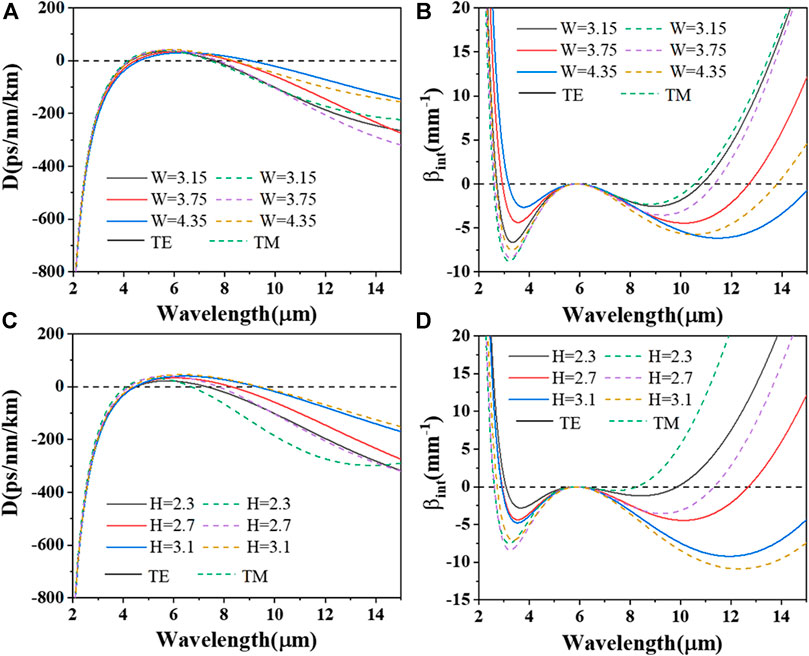
FIGURE 3. (A,C) GVD profiles and (B,D) integrated dispersion profiles with different structural parameters changed. (A,B) The waveguide width W (H = 2.7 μm). (C,D) The waveguide height H (W = 3.75 μm).
Then, the integrated dispersion βint (Figures 3B,D) can be calculated as increasing the waveguide widths W and heights H (which have the same trends as Figures 3A,C) when pumped at 5.8 μm, where two DW phase-matching points can be found in MIR range. The first phase-matching point shifts toward shorter wavelength and the second one shifts toward longer wavelength by increasing W and H of the waveguide. It is noteworthy that although the phase-matching point can shift toward much longer wavelength, the dispersion barrier between pump and DW phase-matching point will also significantly increase, greatly limiting spectral conversion efficiency from soliton to dispersive waves [7]. Therefore, a good balance between bandwidth and efficiency of SCG can be achieved by careful dispersion engineering and choosing appropriate pump wavelength.
Broadband MIR Supercontinuum Generation
Based on the above, in order to obtain broadband SC with relatively high conversion efficiency from soliton to dispersive waves, a GVD profile with two ZWDs located at 4.47 and 8.10 μm for the fundamental TE mode is achieved by setting the structural parameters as W = 3.75 μm and H = 2.7 μm, as shown in Figure 4A. When pumped at 5.8 μm, Figure 4A shows the calculated integrated dispersion of the waveguide when pumped at 5.8 μm, in which two dispersive wave phase-matching points at 2.94 and 12.7 μm can be found, and the dispersion barrier between pump and DW phase-matching point is less than 5 mm−1, leading to efficient broadband SCG.
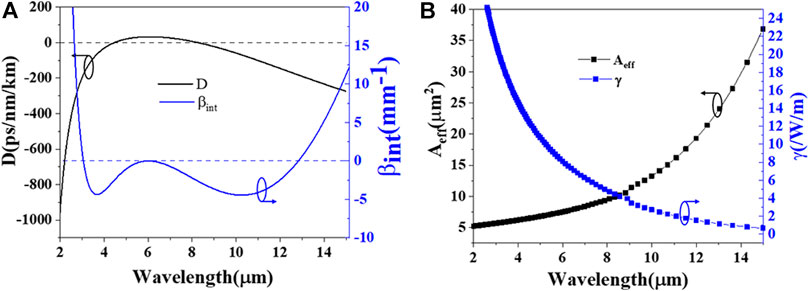
FIGURE 4. (A) Calculated GVD profile and corresponding integrated dispersion. (B) The effective mode area Aeff and nonlinear coefficient γ of the fundamental TE mode in the optimized waveguide (W = 3.75 μm; H = 2.7 μm).
Figure 4B shows the effective mode area and corresponding nonlinear coefficient of the TE mode in the optimized waveguide. The effective mode area increases from 5.2 to 31.5 μm2 with the wavelength from 2 to 14 μm, and γ decreases due to the increased mode area and relatively low confinement. At 5.8 μm, the effective mode area is 7.42 μm2, with a corresponding nonlinear coefficient of 8.32/W/m. A chirp-free hyperbolic secant pulse at 5.8 μm with a peak power of 800 W and FWHM 120 fs is launched into the above-optimized waveguide. At such a pump scheme, the calculated power intensity is 10.78 GW/cm2. Zhao, Z. et al. [26] experimentally demonstrated MIR SCG pumped by an fs pulse at 4.5 μm with ∼150 fs, 1 KHz, average power of 9 mW in a Ge20As20Te45Se15-based step fiber, and corresponding power intensity of ∼15.6 GW/cm2. Although the LDT of Ge20As20Te45Se15 glasses was not measured, the launched power intensity is higher than ours. Besides, Hongya Ou et al. [27] measured the LDT of Ge15Sb25Se60 glasses, and the results indicated that laser-induced damage occurs at a beam intensity of 3674 GW∕cm2 for the Ge15Sb25Se60 bulk glass. Therefore, we are convinced that our proposed waveguide will not be damaged at such peak power intensity.
Figure 5 shows the spectral evolution along the waveguide, and the SCG can be achieved over 11 μm spectral range with power fluctuation of −40 dB when the waveguide with the length of 5 mm is pumped by an fs pulse with peak power P = 800 W, pump wavelength λ0 = 5.8 μm, and tFWHM = 120 fs. The effects of peak power P and center wavelength λ0 of the pump pulse are also investigated with the 120 fs input pulses. As shown in Figure 6, the bandwidth of SC gets larger, and the two-DW generation can be observed gradually as the peak power P increases. Figure 7A shows the calculated integrated dispersion profile for different pump central wavelengths, which indicates the DW phase-matching wavelength can be tuned, as shown in Figure 7B. When pumped at 5.2 μm, the phase-matching wavelength of the DW can even be extended to 13 μm, while the flatness will be limited due to relatively larger dispersion barrier, compared with that pumped at 6.4 μm. According to this result, we can adjust the pump wavelength to generate broader and flatter spectrum.
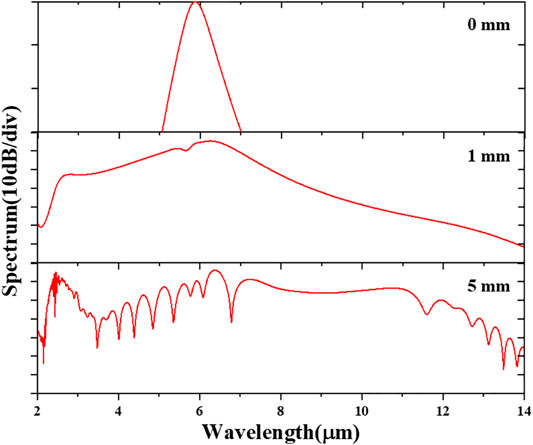
FIGURE 5. Simulated SC results of different waveguide lengths L with peak power P = 800 W, pump wavelength λ0 = 5.8 μm, and tFWHM = 120 fs.
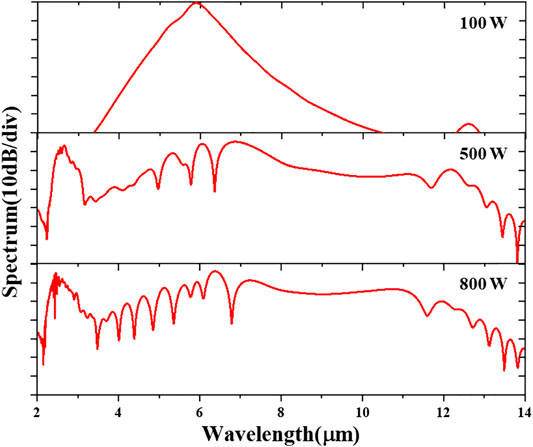
FIGURE 6. Simulated SC results of different peak powers P with waveguide length L = 5 mm, pump wavelength λ0 = 5.8 μm, and tFWHM = 120 fs.
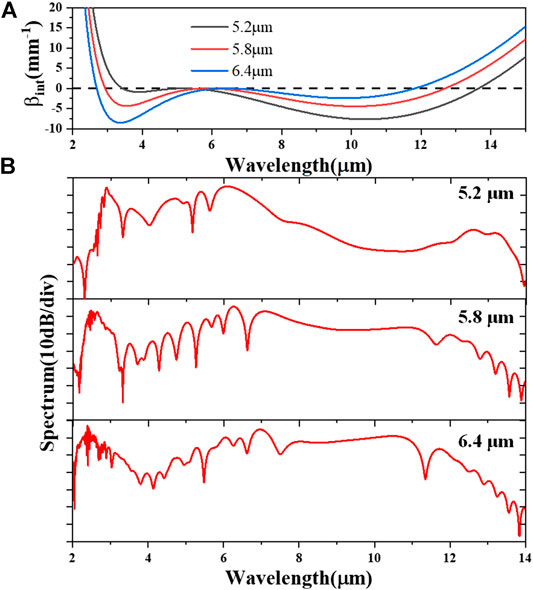
FIGURE 7. Simulated (A) integrated dispersion profiles and (B) SC results of different pump wavelength λ0 with waveguide length L = 5 mm, peak power P = 800 W, and tFWHM = 120 fs.
Table 1 summarizes the SC bandwidth with different peak powers P and center wavelength λ0. When such waveguide with 5 mm length is pumped by a 120 fs pulse with a central wavelength of 6.4 μm and peak power of 800 W, the spectrum expands from 2.05 to 13.18 μm at −40 dB, covering three octaves. To the best of our knowledge, the long-wavelength edge of SC spectrum to ∼13 μm in photonic integrated waveguides is firstly demonstrated. Furthermore, a comparison of our result with other proposed designs by employing various materials is shown in Table 2. These waveguides in Table 2 have various nonlinear coefficients ranging from the lowest being 0.1/W/m to the highest being 630/W/m due to different material platforms, waveguide structures, and central pump wavelength. Among them, although AlGaAs-OI platform offers almost two-order larger nonlinear coefficient than Ge-As-Te-Se in this work, the absorption loss of silica substrate and ultra-small size of the waveguide would limit the practical spectral application in the MIR region. It is noteworthy that nonlinear coefficient gets lower as the pump wavelength increases, while launching the pump pulse at longer wavelength will extend the long-wavelength edge of SC (Table 1). It benefits from higher nonlinear coefficient of our waveguide keeping 8.32/W/m even pumped at wavelength of 5.8 μm, which contributes to the broadband SCG.

TABLE 1. SCG (−40 dB) with different pump powers P and central wavelength λ0 (the unit of the spectrum is μm).
Figures 8A,B show the evolution of the SC generation process during pump pulses propagates along the waveguide, providing us with a description of the soliton dynamics during the propagation. For the SCG, the stronger nonlinear effects compared with dispersion effects of pump pulse are designed to enable a soliton number (
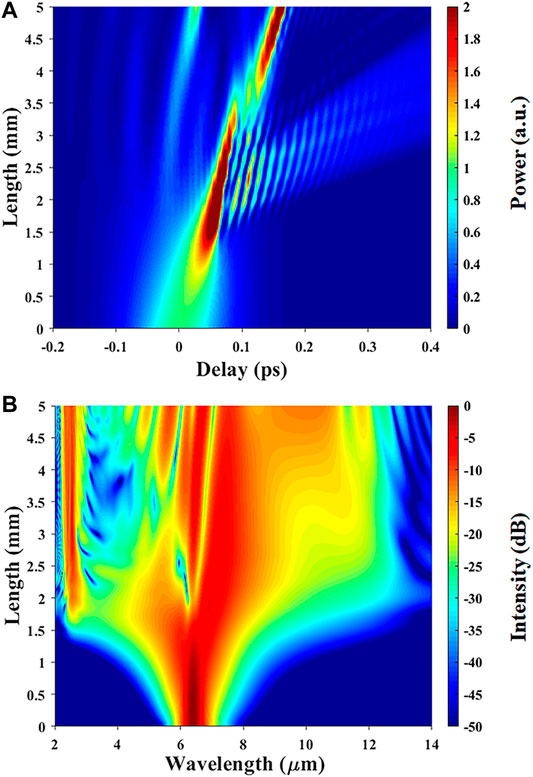
FIGURE 8. (A) Temporal and (B) spectral evolutions (dB scale) of the pump pulse along 5 mm waveguide.
Owing to high-order dispersion and high-order nonlinear effects, if the pump pulse maintains enough energy for broadening the spectrum, the DW can continuously obtain energy from the soliton self-compression process enabling sufficient spectral broadening. This mechanism allows robust generation of DWs, and such DWs emission can efficiently enable broadband SCG in photonic chip-scale waveguides.
Analysis of Fabrication Procedures
Figure 9 explores our ChG waveguide nanofabrication procedure. Firstly, a 6 μm thick Ge-Se lower cladding layer and a 3.75 μm thick Ge-As-Te-Se core layer are deposited by a way of thermal evaporation on a silicon substrate with 3 μm thick thermal oxidation layer. Then, the wafer is purged with nitrogen to form a dry and clean surface on a hot plate at 130°C for 5 min. After that, a 2 nm thick Al2O3 protective layer is applied to prevent the ChG from being oxidized during removing residues resist by inductive coupled plasma etching (ICP-RIE). Afterward, e-beam lithography (EBL) and inductive coupled plasma etching (ICP-RIE) are used to fabricate waveguide, then the residual photoresist of the chip is removed. Finally, the upper cladding was thermally deposited onto the patterned wafer. The all-ChG strip waveguides are fabricated. To reduce the insertion loss, inverse tapers will be designed and fabricated at both ends of the waveguide.
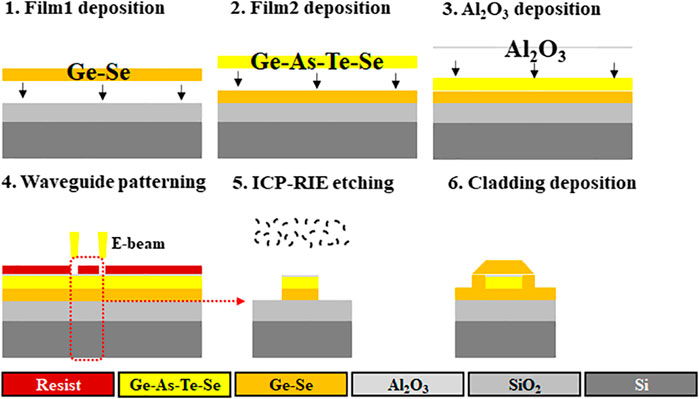
FIGURE 9. A fabrication scheme for the chalcogenide waveguide with a Ge-As-Se-Te core and Ge-Se upper and lower cladding.
Conclusion
A broadband SCG covering the 2–13 μm wavelength has been numerically demonstrated in a compact and high NA Ge-As-Te-Se/Ge-Se chalcogenide waveguide. The influences of geometrical parameters and laser operating conditions are systematically investigated. The DW generation can be observed gradually when increasing the peak power of pump laser, which is conducive to broadening and flattening SCG. This work reveals the potential application for compact, chip-based broadband laser source in detecting fingerprints of the molecules.
Data Availability Statement
The original contributions presented in the study are included in the article/Supplementary Material. Further inquiries can be directed to the corresponding author.
Author Contributions
DX, BZ, and YH designed the structure of the waveguide and simulated and analyzed the supercontinuum spectra; ZY, PZ, HC, and LL prepared the glasses; HS, MZ, YZ, and ZL participated in the discussion of the mechanism of the broadband SC generation.
Funding
The work was supported by the Key Project in Broadband Communication and New Network of the Ministry of Science and Technology (MOST) (2018YFB1801003), National Key R&D Program of China under Grant 2019YFA0706303; National Science Foundation of China (NSFC) (61975242, 62035018, U1701661, U2001601), Key Project for Science and Technology of Guangzhou City (201904020048), The Science and Technology Planning Project of Guangdong Province (2019A1515010774), Science Foundation of Guangzhou City (202002030103).
Conflict of Interest
The authors declare that the research was conducted in the absence of any commercial or financial relationships that could be construed as a potential conflict of interest.
References
1. Yilmaz M, Babur E, Ozdemir M, Gieseking RL, Dede Y, Tamer U, et al. Nanostructured organic semiconductor films for molecular detection with surface-enhanced Raman spectroscopy. Nat Mater (2017) 16(9):918–24. doi:10.1038/nmat4957
2. Hu H, Yang X, Zhai F, Hu D, Liu R, Liu K, et al. Far-field nanoscale infrared spectroscopy of vibrational fingerprints of molecules with graphene plasmons. Nat Commun (2016) 7(1):12334. doi:10.1038/ncomms12334
3. Arroyo JO, Kukura P. Non-fluorescent schemes for single-molecule detection, imaging and spectroscopy. Nat Photon (2016) 10(1):11–7. doi:10.1038/nphoton.2015.251
4. Petersen CR, Møller U, Kubat I, Zhou B, Dupont S, Ramsay J, et al. Mid-infrared supercontinuum covering the 1.4-13.3 μm molecular fingerprint region using ultra-high NA chalcogenide step-index fibre. Nat Photon (2014) 8(11):830–4. doi:10.1038/nphoton.2014.213
5. Kedenburg S, Steinle T, Mörz F, Steinmann A, Giessen H. High-power mid-infrared high repetition-rate supercontinuum source based on a chalcogenide step-index fiber. Opt Lett (2015) 40(11):2668–71. doi:10.1364/ol.40.002668
6. Kita DM, Miranda B, Favela D, Bono D, Michon J, Lin H, et al. High-performance and scalable on-chip digital Fourier transform spectroscopy. Nat Commun (2018) 9(1):4405. doi:10.1038/s41467-018-06773-2
7. Grassani D, Tagkoudi E, Guo H, Herkommer C, Yang F, Kippenberg TJ, et al. Mid infrared gas spectroscopy using efficient fiber laser driven photonic chip-based supercontinuum. Nat Commun (2019) 10(1):1553. doi:10.1038/s41467-019-09590-3
8. Eggleton BJ, Luther-Davies B, Richardson K. Chalcogenide photonics. Nat Photon (2011) 5(3):141–8. doi:10.1038/nphoton.2011.309
9. Yu Y, Gai X, Ma P, Vu K, Yang Z, Wang R, et al. Experimental demonstration of linearly polarized 2-10 μm supercontinuum generation in a chalcogenide rib waveguide. Opt Lett (2016) 41(5):958–61. doi:10.1364/ol.41.000958
10. Shen W, Zeng P, Yang Z, Xia D, Du J, Zhang B, et al. Chalcogenide glass photonic integration for improved 2 μm optical interconnection. Photon Res (2020) 8(9):1484–90. doi:10.1364/prj.398957
11. Fang Y, Bao C, Wang Z, Liu B, Zhang L, Han X, et al. Three-octave supercontinuum generation using SiO2 cladded Si3N4 slot waveguide with all-normal dispersion. J Lightwave Technol (2020) 38(13):3431–8. doi:10.1109/jlt.2020.2985262
12. Zhang L, Lin Q, Yue Y, Yan Y, Beausoleil RG, Willner AE. Silicon waveguide with four zero-dispersion wavelengths and its application in on-chip octave-spanning supercontinuum generation. Opt Express (2012) 20(2):1685–90. doi:10.1364/oe.20.001685
13. Akhmediev N, Karlsson M. Cherenkov radiation emitted by solitons in optical fibers. Phys Rev A (1995) 51(3):2602–7. doi:10.1103/PhysRevA.51.2602
14. Guo H, Herkommer C, Billat A, Grassani D, Zhang C, Pfeiffer MHP, et al. Mid-infrared frequency comb via coherent dispersive wave generation in silicon nitride nanophotonic waveguides. Nat Photon (2018) 12(6):330–5. doi:10.1038/s41566-018-0144-1
15. Tagkoudi E, Grassani D, Yang F, Herkommer C, Kippenberg T, Brès CS. Parallel gas spectroscopy using mid-infrared supercontinuum from a single Si3N4 waveguide. Opt Lett (2020) 45(8):2195–8. doi:10.1364/OL.390086
16. Yang Z, Luo T, Jiang S, Geng J, Lucas P. Single-mode low-loss optical fibers for long-wave infrared transmission. Opt Lett (2010) 35(20):3360–2. doi:10.1364/ol.35.003360
17. Tao G, Shabahang S, Ren H, Khalilzadeh-Rezaie F, Peale RE, Yang Z, et al. Robust multimaterial tellurium-based chalcogenide glass fibers for mid-wave and long-wave infrared transmission. Opt Lett (2014) 39(13):4009–12. doi:10.1364/OL.39.004009
18. Wang T, Gai X, Wei W, Wang R, Yang Z, Shen X, et al. Systematic z-scan measurements of the third order nonlinearity of chalcogenide glasses. Opt Mater Express (2014) 4(5):1011–22. doi:10.1364/ome.4.001011
19. Dudley JM, Genty G, Coen S. Supercontinuum generation in photonic crystal fiber. Rev Mod Phys (2006) 78(4):1135–84. doi:10.1103/RevModPhys.78.1135
20. Chen C-M, Kelley PL. Nonlinear pulse compression in optical fibers: scaling laws and numerical analysis. J Opt Soc Am B (2002) 19(9):1961–7. doi:10.1364/josab.19.001961
22. Hu J, Menyuk CR, Shaw LB, Sanghera JS, Aggarwal ID. Maximizing the bandwidth of supercontinuum generation in As2Se3 chalcogenide fibers. Opt Express (2010) 18(7):6722–39. doi:10.1364/oe.18.006722
23. Karpov M, Guo H, Kordts A, Brasch V, Pfeiffer MH, Zervas M, et al. Raman self-frequency shift of dissipative Kerr solitons in an optical microresonator. Phys Rev Lett (2016) 116(10):103902. doi:10.1103/PhysRevLett.116.103902
24. Roy S, Bhadra SK, Agrawal GP. Effects of higher-order dispersion on resonant dispersive waves emitted by solitons. Opt Lett (2009) 34(13):2072–4. doi:10.1364/ol.34.002072
25. You C, Dai S, Zhang P, Xu Y, Wang Y, Xu D, et al. Mid-infrared femtosecond laser-induced damages in As2S3 and As2Se3 chalcogenide glasses. Sci Rep (2017) 7(1):6497. doi:10.1038/s41598-017-06592-3
26. Zhao Z, Wang X, Dai S, Pan Z, Liu S, Sun L, et al. 1.5-14 μm midinfrared supercontinuum generation in a low-loss Te-based chalcogenide step-index fiber. Opt Lett (2016) 41(22):5222–5. doi:10.1364/OL.41.005222
27. Ou H, Dai S, Zhang P, Liu Z, Wang X, Chen F, et al. Ultrabroad supercontinuum generated from a highly nonlinear Ge-Sb-Se fiber. Opt Lett (2016) 41(14):3201–4. doi:10.1364/OL.41.003201
28. Saini TS, Trung Hoa NP, Nagasaka K, Luo X, Tuan TH, Suzuki T, et al. Coherent midinfrared supercontinuum generation using a rib waveguide pumped with 200 fs laser pulses at 2.8 μm. Appl Opt (2018) 57(7):1689–93. doi:10.1364/ao.57.001689
29. Saini TS, Tiwari UK, Sinha RK. Rib waveguide in Ga-Sb-S chalcogenide glass for on-chip mid-IR supercontinuum sources: design and analysis. J Appl Phys (2017) 122(5):053104. doi:10.1063/1.4997541
30. Ahmad H, Karim MR, Rahman BMA. Modeling of dispersion engineered chalcogenide rib waveguide for ultraflat mid-infrared supercontinuum generation in all-normal dispersion regime. Appl Phys B (2018) 124(3):6914. doi:10.1007/s00340-018-6914-0
31. Sinobad M, Monat C, Luther-Davies B, Ma P, Madden S, Moss DJ, et al. Mid-infrared octave spanning supercontinuum generation to 85 μm in silicon-germanium waveguides. Optica (2018) 5(4):360–6. doi:10.1364/optica.5.000360
32. Jafari Z, Wang J, Guo Y, Yang M, Zarifkar A, Liu H, et al. Efficient supercontinuum generation enabled by dispersion engineering in a dual-core waveguide. Opt Commun (2020) 457(1):124664. doi:10.1016/j.optcom.2019.124664
33. Sharma R, Kaur S, Chauhan P, Kumar A. Computational design & analysis of GeSe2-As2Se3-PbSe based rib waveguide for mid-infrared supercontinuum generation. Optik (2020) 220(1):165032. doi:10.1016/j.ijleo.2020.165032
Keywords: supercontinuum generation, mid-infrared, waveguides, chalcogenides, on-chip
Citation: Xia D, Huang Y, Zhang B, Yang Z, Zeng P, Shang H, Cheng H, Liu L, Zhang M, Zhu Y and Li Z (2021) On-Chip Broadband Mid-Infrared Supercontinuum Generation Based on Highly Nonlinear Chalcogenide Glass Waveguides. Front. Phys. 9:598091. doi: 10.3389/fphy.2021.598091
Received: 31 August 2020; Accepted: 05 February 2021;
Published: 13 April 2021.
Edited by:
Jin Li, Northeastern University, ChinaReviewed by:
Venugopal Rao Soma, University of Hyderabad, IndiaHanyang Li, Harbin Engineering University, China
Copyright © 2021 Xia, Huang, Zhang, Yang, Zeng, Shang, Cheng, Liu, Zhang, Zhu and Li. This is an open-access article distributed under the terms of the Creative Commons Attribution License (CC BY). The use, distribution or reproduction in other forums is permitted, provided the original author(s) and the copyright owner(s) are credited and that the original publication in this journal is cited, in accordance with accepted academic practice. No use, distribution or reproduction is permitted which does not comply with these terms.
*Correspondence: Bin Zhang, zhangbin5@mail.sysu.edu.cn
 Di Xia1
Di Xia1  Bin Zhang
Bin Zhang Pingyang Zeng
Pingyang Zeng